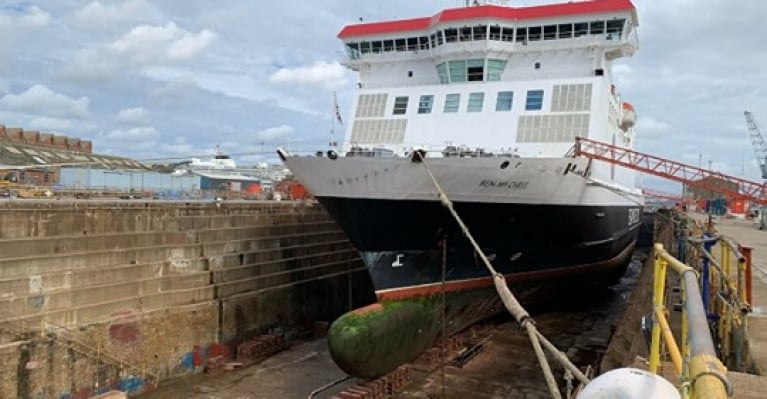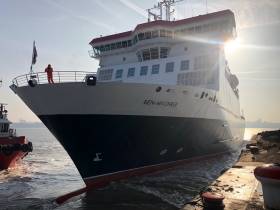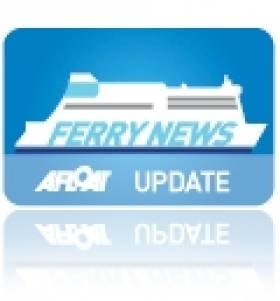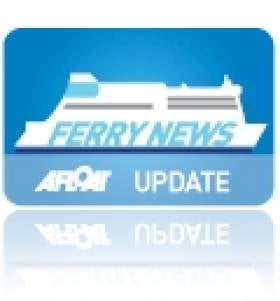Displaying items by tag: BenMyChree
What's Next for Former Isle of Man Flagship? - House of Keys to Discuss
As 3FM radio reports, what's next for the Isle of Man Steam Packet ferry the Ben-My-Chree?
The ropax is the the former flagship of the Manx Government owned company which after 25 years last year was replaced by newbuild Manxman when entering service in August.
The question was being asked by Central Douglas, Member of House of Keys (MHK) Chris Thomas, following the ferry’s placement into a reserve vessel where it remains berthed in Douglas as referenced recently in separate Irish Ferries story.
During a sitting at this week’s House of Keys, the MHK is to ask the Treasury Minister, Dr Alex Allinson about the future role of the 1998 built ferry which had served the island’s main and only year-round operated route of Douglas-Heysham.
The Ben-My-Chree also served seasonal routes; Douglas-Belfast/ Dublin though Afloat highlights the latter link to the Irish capital was conducted in the earlier years. The vessel carried 630 passengers, 275 cars and 90 freight trailers.
Mr. Thomas wants to inquire how the 12,747 gross tonnes Ben-my-Chree can be used and what plans does the Steam Packet Company have for the almost 125m long vessel.
The main Isle of Man ferry, the ro-pax Ben-my-Chree is expected to be in shipyard dry dock for a further six days following issues discovered during a routine annual maintenance.
Operator, Isle of Man Steam Packet says worn bearings on the vessel need replacing.
According to Manx Radio, it means the 'Ben' will now return to service on Thursday, 13 May, in time for the morning 8:45am sailing to Heysham.
Until then, the fastcraft Manannan will continue the daytime sailing service to the Lancashire port, whilst the MV Arrow will be in charge of bringing freight across.
Meanwhile, (today's) Monday's daytime sailings to Heysham are subject to possible disruption or cancellation.
Manx Ferry Returns to Scheduled Services
#ferries - The ferry Ben-My-Chree operated by the Isle of Man Steam Packet has been confirmed by the company of its return to Manx waters yesterday.
Manx Radio reports the ferry's arrival (in Douglas) follows what the operator called "successful regulatory overhaul" at Cammell Laird in Birkenhead.
In a post on social media, staff said they are "pleased to welcome her back" and "look forward to her returning to scheduled services" tomorrow (Thursday).
To see details on sailings in full, click here.
#ferries - The Isle of Man Steam Packet Company's main ferry, the ropax Ben-my-Chree arrived on Merseyside today to undergo an annual regulatory overhaul.
The work on the 12,000 gross tonnage vehicle ferry with capacity for 630 passengers is to take place at Cammell Laird, the shiprepairer and shipbuilder located in Birkenhead.
The ferry entered the dry-dock at the marine engineering facility on the Wirral Peninsula for one week and is scheduled to return to service on Thursday 2nd May.
In the meantime fast craft Manannan will operate the 'Ben's passenger services on the Douglas-Heysham/Liverpool routes during this period, as per the timetable published last autumn. The MV Arrow, which the Steam Packet Company currently has on charter, will provide freight services.
During the overhaul, Manannan will depart Douglas for Heysham at 08:00 and for Liverpool at 15:30 each day, with the return sailings departing Heysham at 12:00 and Liverpool at 19:15.
A replacement coach service will be provided at Heysham to transfer foot passengers to and from Lancaster railway station.
#FerryCaptainInterview - In our first of a series of interviews with Irish Sea ferry captains, Jehan Ashmore talks to Captain Allan Albiston, master of the Isle of Man Steam Packet Company's ro-pax ferry Ben-My-Chree, the Manx for 'Girl of My Heart'.
Captain Albiston's career has spanned more than four decades and his current command of the 600-passenger and vehicle ferry is principally employed operating the main link to the UK between Douglas-Heysham. In addition to running during the winter months to Birkenhead and on occasions of the seasonal-only service to Dublin Port.
Since entering service in 1998, the Dutch built ferry of 12,504 tonnes has been the workhorse of the company. She recently re-entered service fresh from an overhaul and refurbishment costing £1.6m to enhance passenger facilities and for those of her crew.
What first inspired you to thinking of having a career at sea?
My mother was born in the Isle of Man and so as a child I spent summer holidays on the island travelling by boat.
I spent my school summer holidays working on the rowing boats in Douglas and when I was old enough, as a steward on the last Ben-My-Chree between 1969 – 1971. Seven years later in 1978, I returned to the Steam Packet Company as a second officer.
Has there been an individual or seafaring background that has influenced your career?
My mother's family had fishing boats in Laxey during the early part of the 20th century so I guess it was in the blood somewhere.
What college did you attend?
I studied at the Fleetwood Nautical College.
The Isle of Man Steam Packet Company's ro-pax ferry Ben-My-Chree
The onboard Coast to Coast Cafe
What companies have you served and trading routes or regions?
For seven years served as as cadet and third officer with Andrew Wier (Bank Line) trading Worldwide to Africa, India, North & South America, Asia, Australia, New Zealand and Pacific Islands. Also had two winters with Manchester Liners trading to Montreal and to the Mediterranean Sea.
It was great fun seeing lots of the world in those years, but I wouldn't want to do it today. It's all about visiting container ports and oil terminals miles away from the city ports we used to visit.
Name the first ship that you took command?
The first vessel I took command of was the fast-craft ferry, Seacat Isle of Man.
What is your weekly routine in terms of managing crew operations of Ben-My-Chree?
The day to day running of crew operations is carried out by the heads of department, the Chief Engineer, Chief Officer and Passenger Services Officer – that look after their areas but as master, I am in overall charge of everything and everybody on board - it is all encompassing and ultimately I am responsible for all safety and crew training.
What aspects do you like serving on a multi-purpose ferry?
As Master, the vessel type is not as important as the route and schedule. The advantage of short sea routes means that regular leave periods, allows for a reasonably cohesive home life which is not enjoyed by mariners serving in deep sea trades.
What reasons make the ro-pax ferry suited to this short service on the Irish Sea?
It gives car and foot passengers an opportunity to travel from the Island twice a day 364 days a year which would not be possible with a split passenger / freight service.
Since her recent biennual overhaul, what has improved in terms of passenger facilities?
The main passenger lounge, the Coast to Coast Café, has been upgraded and is much brighter and airier giving a feeling of more space. The Legend's Bar area has also benefitted from new seating.
How many crossings does the ship make while working on the main link between the island and the UK mainland?
Apart from a routine maintenance night once a month and Christmas day, the vessel sails 28 crossings every week of the year, two in each direction daily.
Asides the Heysham-Douglas route, which seasonal operated route do you like to serve on across the Steam Packet network and why?
As senior master on Ben-my-Chree, the latest vessel to bear this famous 'steam-packet' name, I rarely do other routes apart from Birkenhead during the winter months.
People may not think there is much excitement sailing from Douglas to Heysham every day, with the occasional trip to Birkenhead, but there are lots of challenges.
Last winter we had atrocious weather, which was very challenging, and we sometimes have other problems to resolve as well as crew and customer issues to deal with on sailings, so there are plenty of challenges on a day-to-day basis.
When I was Master on the fast craft, which I commanded from 1997 until 2010, I liked the variety of operating different routes rather than having a specific favourite.
From a scenic perspective, the Belfast route was more interesting as we sometimes go south of the Isle of Man and sometimes north depending upon tidal conditions.
On leave, what are your favourite activities and pastimes?
I have a secondary occupation doing safety management for a large yacht company and this takes me to the Caribbean in winter and the Mediterranean in summer but I have also been to Australia and Brazil.
Travel abroad both for work and family holidays continues to be my favourite pastime with a couple of ski holidays thrown in.
Extra Freight Ferry Chartered for Manx TT Races
#MANX TT RACES FERRY NEWS – According to BBC News, an additional ro-ro freight-ferry has been chartered from Seatruck Ferries by the Isle of Man Steam Packet Company in order to cope with demand during the TT races.
More than 11,200 motorbikes are already booked to arrive in Douglas during race fortnight, which begins on Monday. The number is the highest for a decade with the exception of the event's centenary in 2007.
The chartered vessel is the Arrow (1998/7,606grt), which will assist in peak periods. The 122m long vessel can transport around 1,000 metres of freight and is the sister ship of Helliar, which covered during the island's passenger ferry Ben-my-Chree's scheduled dry dock.
Steam Packet Company Chief Executive Mark Woodward said: "While MV Arrow doesn't bring any additional passenger space, we have already made provision for 43,000 extra seats scheduled over the TT period."
"This second chartered vessel provides additional operational resilience during the busiest time of the year."
Bank Holiday Marks Start of Manx Sailings
#ISLE OF MAN FERRY – This Easter bank holiday weekend marks the start of the Isle of Man Steam Packet Co.'s seasonal-only Dublin-Douglas ferry service, with a sailing scheduled to depart this evening, writes Jehan Ashmore.
The wave-piercing catamaran fastcraft Manannan had departed the Manx capital this afternoon to form the inaugural outbound sailing, which takes nearly three hours to complete. The 96m fastcraft is the largest of her type in the Irish Sea and she was built by InCAT in Hobart, Tasmania. She also maintains sailings on the Douglas to Belfast and Liverpool routes.
For sailing timetables across the network of routes to the Isle of Man click HERE and for a guide about the fastcraft and conventional ferry Ben-My-Chree click this LINK.
Ferry Changes on Dublin-Isle of Man Route
#FERRY NEWS- This weekend's round-trip Douglas-Dublin sailings are to be served by fast-ferry Manannan (1998/5,743grt) instead of conventional ferry, writes Jehan Ashmore.
Usually these winter sailings are operated by Ben-My-Chree (1998/12,504grt), as the Dutch built ro-pax is in dry-dock at Cammell Laird, Birkenhead for repairs to her bow-thruster.
The InCAT built Manannan will cover these sailings with an arrival in Dublin Port this evening at 22.00hrs. She spends a short-around in port lasting only 45 minutes, before returning to the Manx capital.
Manx Seasonal Visitor to Dublin Port
Following this mornings Irish route sailing, she resumed on her regular Douglas-Heysham route and she also serves Douglas-Birkenhead (Liverpool) during the winter months.
During the summer Dublin-Douglas sailings are served by fast-ferry catamaran Manannan (1998/5,743grt). The 96m InCAT built in Hobart,Tasmania had also operated Douglas-Belfast high-season crossings. Her roster is now confined to a Douglas-Liverpool sailing schedule.
Ben-My-Chree (photo) is Manx for 'Girl of my heart' and her island owners commissioned the 12,504grt ro-pax from Dutch shipbuilders Van de Giessen-de Noord. The 125m ferry was launched in 1998 and she can accommodate 630 passengers,275 vehicles and 1,235 freight lane-metres.
This particular ro-pax design has also been built for Channel Islands operator Commodore Ferries with their Commodore Clipper and a Scandinavian ferry operator. In addition another Dutch shipbuilder, Merwede built a multi-support vessel (MRV) derived from the design of Ben-My-Chree for the Royal New Zealand Navy when they commissioned HMNZS Canterbury (L421). Click for similar port-side photo view to compare differences.
Incidentally the Manannan prior to entering service last year for the IOMSPCo. was for five years chartered initially to the United States Navy but transferred to the United States Army Forces. To read more click HERE.
Irish Sea Cross Channel Fast-Ferry Services On Declining Trend
The third service between Belfast-Stranraer is in the hands of rivals Stena Line which maintain the HSS Stena Voyager (1996/19,638 grt) on sailings but only to around mid-November. She will be replaced by conventional sister-ships which will be introduced on the North Channel's newest port when services switch from Stranraer to a new terminal close to Cairnryan.
Finally the fourth fast-ferry is Irish Ferries marketed 'Dublin Swift' service which runs on the Dublin-Holyhead route served by Jonathan Swift (1999/5,989 grt). The craft built by Austal in Fremantle, operates alongside the conventional cruise-ferry Ulysses.
Stena Line's decision to terminate HSS Stena Explorer sailings between Dun Laoghaire-Holyhead this day last week follows fast-ferry Stena Lynx III's end-of-season Rosslare-Fishguard sailings earlier this month.
From next year, Dun Laoghaire-Holyhead sailings are to be seasonal-only and according to Stena Line they hope to resume fast-ferry sailings in April or May though no exact date has been set. Unlike the central corridor route which was entirely dependent on HSS operations, the Rosslare-Fishguard route remains operating year-round with the conventional ferry Stena Europe.
As a result of the discontinued fast-ferries, the HSS Stena Explorer is now spending a lay-up period in the Welsh port for the winter. The smaller Stena Lynx III is also 'wintering' but in on the opposite side of the Irish Sea in Dun Laoghaire, where the vessel has done so in previous years.
The lay-up of both fast-ferries in Dun Laoghaire and Holyhead is ironic considering that neither ports' are connected by the very craft that used to share sailing rosters in recent years. In addition the wintering of these catamaran craft is the first time that this has occurred since the pioneering Stena Sea Lynx fast-ferry launched such sailings in 1993.
This first 'Lynx' provided seasonal sailings on the route with conventional car-ferry Stena Hibernia, the former St. Columba, custom-built in 1977 for Sealink /British Rail. She was given a second name under Stena ownership, the Stena Adventurer and remained on the 57 nautical-mile route until replaced in 1996 by the year-round operated HSS Stena Explorer.
Apart from cross-channel fast-ferry services, the Isle of Man is served by the Isle of Man Steam Packet Co. Ltd's routes linking the islands capital Douglas with Belfast, Dublin, Heysham and Liverpool (Birkenhead) in the winter. These routes include seasonal services which are operated by a combination of conventional tonnage using Ben-My-Chree and fast-ferry Manannan (1998/5,089grt), a former US Navy vessel, to read more click HERE. For sailing schedules, vessel type deployed on route and for fares click HERE.
- Dublin Port
- Irish Ferries
- Dun Laoghaire
- Stena Europe
- Holyhead
- P&O Ferries
- Belfast Harbour
- Stena Line
- Larne
- Ports and Shipping News
- Ulysses
- P&O (Irish Sea)
- Cairnryan
- Ferry news
- Stena Explorer
- Stena Express
- FastFerries
- Cruiseferry
- Manannan
- Isle of Man Steam Packet Co.
- Stena Voyager
- Belast Port
- Isle of Man ferry services
- P&O Express
- Irish Sea fastferries
- Stena 'Lynx'
- BenMyChree
- Dublin Swift
- Stena Sea Lynx






































































